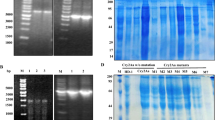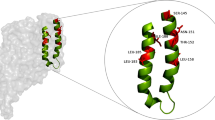Abstract
A fusion gene was constructed by combining the cry1Ac gene of Bacillus thuringiensis strain 4.0718 with a neurotoxin gene, hwtx-1, which was synthesized chemically. In this process, an enterokinase recognition site sequence was inserted in frame between two genes, and the fusion gene, including the promoter and the terminator of the cry1Ac gene, was cloned into the shuttle vector pHT304 to obtain a new expression vector, pXL43. A 138-kDa fusion protein was mass-expressed in the recombinant strain XL002, which was generated by transforming pXL43 into B. thuringiensis acrystalliferous strain XBU001. Quantitative analysis indicated that the expressed protein accounted for 61.38% of total cellular proteins. Under atomic force microscopy, there were some bipyramidal crystals with a size of 1.0 × 2.0 μm. Bioassay showed that the fusion crystals from recombinant strain XL002 had a higher toxicity than the original Cry1Ac crystal protein against third-instar larvae of Plutella xylostella, with an LC50 (after 48 h) value of 5.12 μg/mL. The study will enhance the toxicity of B. thuringiensis Cry toxins and set the groundwork for constructing fusion genes of the B. thuringiensis cry gene and other foreign toxin genes and recombinant strains with high toxicity.


Similar content being viewed by others
References
Aronson A (2002) Sporulation and delta-endotoxin synthesis by Bacillus thuringiensis. Cell Mol Life Sci 59:417–425
Ausubel FM, Brent R, Kingston RE, Moore DD, Seidman JG, Smith JA, Struhl K (1995) Short protocols in molecular biology, 3rd edn. John Wiley & Sons, New York
Bosch D, Schipper B, Kleij D, Maagd RA, Stiekema WJ (1994) Recombinant Bacillus thuringiensis crystal proteins with new properties: possibilities for resistance management. Biotechnology 12:915–918
Chang L, Grant R, Aronson A (2001) Regulation of the packaging of Bacillus thuringiensis δ-endotoxins into inclusions. Appl Environ Microbiol 67:5032–5036
Chen XJ, Lee MK, Dean DH (1993) Site-directed mutations in a highly conserved region of Bacillus thuringiensis δ-endotoxin affect inhibition of short circuit current across Bombyx mori midgets. Proc Natl Acad Sci USA 90:9041–9045
Crickmore N, Zeigler DR, Feitelson J, Schnepf E, Van Rie J, Lereclus D, Baum J, Dean DH (1998) Revision of the nomenclature for the Bacillus thuringiensis pesticidal crystal proteins. Microbiol Mol Biol Rev 62:807–813
Ding XZ, Liu QL, Mo XT, Gao BD, Xia LQ (2003) Characterization of insecticidal crystal proteins genes from Bacillus thuringiensis 4.0718 strain. Acta Microbiol Sinica 43:413–417
Ding XZ, Luo ZH, Xia LQ, Gao BD, Sun YJ, Zhang YM (2008) Improving the insecticidal activity by expression of a recombinant cry1Ac gene with chitinase-encoding gene in acrystalliferous Bacillus thuringiensis. Curr Microbiol 56:442–446
Guo SD, Cui HZ, Xia LQ, Wu DL, Ni WZ, Zhang ZL, Zhang BL, Xu YJ (1999) Study on double-effect resistant insects transgenic cotton. Sci Agric Sinica 32:1–7
Guo SD, Cui HZ, Xia LQ et al (1999) Development of bivalent insect-resistant transgenic cotton plants. Sci Agric Sinica 32(3):1–7
Li M, Li LY, Wu X, Liang SP (2000) Cloning and functional expression of a synthetic gene encoding huwentoxin-I, a neurotoxin from the Chinese bird spider (Selenocosmia huwena). Toxicon 38:153–162
Liang SP, Zhang DY, Pan X, Chen Q, Zhou PA (1993) Properties and amino acid sequence of tuwentoxin-1, a neurotoxin purified from the venom of the Chinese bird spider Selenocosmia huwena. Toxicon 31:969–978
Liu YB, Tabashnik BE, Denneby TJ et al (1999) Development time and resistance to Bacillus thuringiensis crops. Nature 400:501–502
MacIntosh SC, Stone TB, Sims SR, Hunst PL, Greenplate JT, Marrone PG, Perlak FJ, Fischhoff DA, Fuchs RL (1990) Specificity and efficacy of purified Bacillus thuringiensis proteins against agronomically important insects. J Invertebr Pathol 56:258–266
Morán R, García R, López A, Zaldúa Z, Mena J, García M, Armas R, Somonte D, Rodríguez J, Gómez M, Pimentel E (1998) Transgenic sweet potato plants carrying the delta-endotoxin gene from Bacillus thuringiensis var. tenebrionis. Plant Sci 139:175–184
Neirlich DP, Murakawa GJ (1996) The decay of bacterial messenger RNA. Prog Nucleic Acid Res Mol Biol 52:153–216
Qu Y, Liang S, Ding J, Ma L, Zhang R, Gu X (1995) Proton nuclear magnetic resonance studies on huwentoxin-I from the venom of the spider Selenocosmia huwena: 1. Sequence-specific 1H-NMR assignments. J Protein Chem 14:549–557
Palidam M (1992) The insecticidal crystal protein Cry1A(c) from Bacillus thuringiensis in highly toxic for Heliothis armigera. J Invertebr Pathol 59:109–111
Park HW, Ge B, Bauer LS, Federici BA (1998) Optimization of Cry3A yields in Bacillus thuringiensis by use of sporulation-dependent promoters in combination with the STAB-SD mRNA sequence. Appl Environ Microbiol 64:3932–3938
Sambrook J, Fritsch EF, Maniatis T (1989) Molecular cloning:a laboratory manual, 2nd edn. Cold Spring Harbor Laboratory Press, Cold Spring Harbor, NY
Wong HC, Schnepf HE, Whiteley HR (1983) Transcriptional and translational start sites for the Bacillus thuringiensis crystal protein gene. J Biol Chem 258:1960–1967
Acknowledgments
This research was supported by the National Natural Science Foundation of China (No. 30670052 and 30870064), the National 863 Project of China (Nos. 2006AA02Z187 and 2006AA10A212), the Research Fund for the Doctoral Program of Higher Education (No. 20060542006), and the Provincial Natural Science Foundation of Hunan (No. 06JJ2009).
Author information
Authors and Affiliations
Corresponding author
Additional information
LiQiu Xia and XiaoShan Long contributed equally to this work.
Rights and permissions
About this article
Cite this article
Xia, L., Long, X., Ding, X. et al. Increase in Insecticidal Toxicity by Fusion of the cry1Ac Gene from Bacillus thuringiensis with the Neurotoxin Gene hwtx-I . Curr Microbiol 58, 52–57 (2009). https://doi.org/10.1007/s00284-008-9265-y
Received:
Revised:
Accepted:
Published:
Issue Date:
DOI: https://doi.org/10.1007/s00284-008-9265-y




